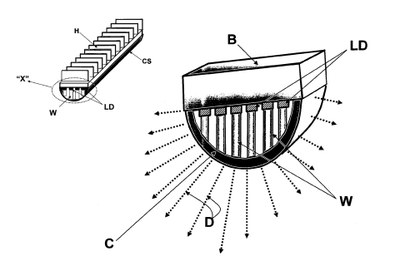New Patent Aims to Improve Light Distribution of Tubular Lamps and Luminaires
Appropriate even light distribution in LED replacement tubes respectively tubular LED lamps and luminaires is still one of the weak points of LED lighting. Recently the interesting patent application "Light distribution using tapered waveguides in LED-based tubular lamps as replacements of linear fluorescent lamps" covering that topic became a granted patent, with patent number US8,348,467 B2.
Original Abstract:
An LED replacement-lamp design concept comprising tapered waveguides to provide uniform and broad light distribution is disclosed. Currently, most LED-based replacement lamps for tubular fluorescent lamps place discrete surface-mount LEDs directly on a cylindrical base, which produce wasteful, non-uniform and directional illumination unsuitable for large space and high-ceiling applications. An LED lamp design, proposed as a tubular lamp replacement, comprises of a plurality of discrete LEDs mounted on a common substrate, where all light from each LED is immediately guided and broadened through a tapered waveguide long enough to seamlessly terminate at the lamp's semi-circularly curved cover surface. Many such LED-waveguide assemblies can fill the entire curved cover with diffused and uniform light distribution, resulting in illumination over broad angular ranges. The proposed lamp has a “D” shaped cross-section wherein the lamp's flat side is used as a heat-sink base to be placed against the ceiling or some blocking surface.
In this invention disclosure, I, M. Nisa Khan from LED Lighting Technologies, claims the patent ownership of the following:
1. An LED replacement lamp for replacing a tubular or linear fluorescent light comprising: (a) a base board; (b) a plurality of LEDs mounted on the base board; (c) a plurality of optical waveguides, having an incident surface and an exit surface; wherein each of the LEDs has a corresponding waveguide and all the light emitted from each of the LEDs immediately enters the corresponding waveguide's incident surface, after which it is guided through the waveguide core and then exits at the exit surface; (d) a cover which accepts the light exiting the exit surfaces of the plurality of waveguides wherein the waveguides have an adiabatic or slowly varying increase in their core or light-guiding region's cross-sectional area as the distance from the LED increases which allows diffusion or broadening of light from each LED source at the cover's surface.
2....
The full patent document can be downloaded at http://www.freepatentsonline.com/8348467.pdf or directly from our website


